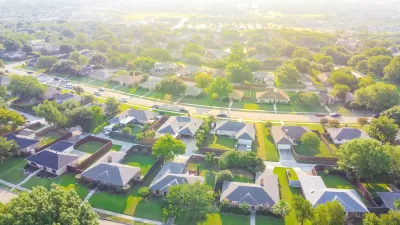Small, often wealthy enclaves build far less multifamily housing than their larger counterparts, exacerbating the dearth of affordable housing near big cities and job centers.

In an article in The Conversation, Paul G. Lewis and Nicholas J. Marantz explain how small, wealthy suburbs contribute to California’s housing crisis by resisting state efforts to mandate or encourage more housing construction.
The authors used census tract data to examine multifamily housing development in cities of various sizes between 2008 and 2018. “Over that span, according to our statistical estimates, a typical neighborhood-size census tract located within a city of 100,000 residents saw the development of 46 more new multifamily units than an otherwise very similar census tract located within a smaller city of 30,000 residents.”
This data reveals that smaller towns are less likely to add sorely needed apartments and other multifamily housing types. When the analysis was expanded to the entire country, the pattern was similar. Wealthy suburbs, often on the outskirts of large cities, fight new housing development; new housing development, if it happens, is pushed farther out, extending commutes and aggravating sprawl.
The authors explain that the nature of small cities makes them prone to political interests that skew toward the status quo. “To be sure, many homeowners in big cities have similar worries. But in a large, diverse city, anti-growth voices often are counterbalanced by pro-housing interests active in city politics, such as large employers, developers, construction unions or affordable-housing nonprofits.”
The article lists the possible mandates and incentives states have implemented to reduce barriers to housing construction, but, as evidenced by Silicon Valley cities, NIMBY groups will attempt creative ways to skirt regulations. In one ambitious example from Oregon, “Voters created and then strengthened an elective metro government to not just plan but actually carry out key regional land-use priorities” in the Portland region.
FULL STORY: How small wealthy suburbs contribute to regional housing problems

Alabama: Trump Terminates Settlements for Black Communities Harmed By Raw Sewage
Trump deemed the landmark civil rights agreement “illegal DEI and environmental justice policy.”

Planetizen Federal Action Tracker
A weekly monitor of how Trump’s orders and actions are impacting planners and planning in America.

The 120 Year Old Tiny Home Villages That Sheltered San Francisco’s Earthquake Refugees
More than a century ago, San Francisco mobilized to house thousands of residents displaced by the 1906 earthquake. Could their strategy offer a model for the present?

Ken Jennings Launches Transit Web Series
The Jeopardy champ wants you to ride public transit.

BLM To Rescind Public Lands Rule
The change will downgrade conservation, once again putting federal land at risk for mining and other extractive uses.

Indy Neighborhood Group Builds Temporary Multi-Use Path
Community members, aided in part by funding from the city, repurposed a vehicle lane to create a protected bike and pedestrian path for the summer season.
Urban Design for Planners 1: Software Tools
This six-course series explores essential urban design concepts using open source software and equips planners with the tools they need to participate fully in the urban design process.
Planning for Universal Design
Learn the tools for implementing Universal Design in planning regulations.
Clanton & Associates, Inc.
Jessamine County Fiscal Court
Institute for Housing and Urban Development Studies (IHS)
City of Grandview
Harvard GSD Executive Education
Toledo-Lucas County Plan Commissions
Salt Lake City
NYU Wagner Graduate School of Public Service





























